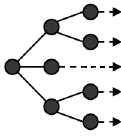



An assembly shop order is an electronic document that authorizes the assembly of items. You use an assembly shop order to re-assemble items previously disassembled, dispositioned and possibly repaired. If, during the disassembly process, a structure mismatch was found, it must be resolved before work can proceed on the assembly shop order.
An assembly shop order is similar to a standard shop order. The primary difference is:
The assembly shop order follows a disposition shop order or a repair shop order in the MRO process. It is is followed by either a higher-level assembly order or the receipt of the overhaul object.
The following table summarizes the different types of MRO shop orders, so that you can better understand how assembly shop orders fit into the MRO manufacturing process.
| MRO Order Structure |  |
 |
 |
 |
| Type of MRO Shop Order | Disassembly | Disposition | Repair | Assembly |
| Source of Material | Work order for overhaul object or previous disassembly order | Disassembly order | Disposition order | Inventory, disposition order, or repair order |
| Expected Output | Components identified to be disassembled and remainder of overhauled part | Disposition lines identifying what is to be done with the parts (receive or scrap) and repair orders | Repaired part | Overhauled object or reassembled component |
| Position Parts/Identified Real Parts | Created for position parts, results in identified real parts | Created for position parts, assigned real parts after the parts are identified, results in real parts | Real parts throughout | Created initially for position parts, assigned real parts after the parts are identified |
Assembly shop orders are generated either during the initial work scope process or during work scope re-evaluation. The work scope re-evaluation might discover that further disassembly (and the corresponding re-assembly) is necessary. The assembly shop order is created with the Assembly shop order type and is originally allocated the position parts required for assembly. As parts are identified during the disassembly process, the real part information replaces the position part material requirements on the corresponding assembly shop order. When the assembly shop order is created, the system creates the material requirements for the items to be re-assembled and then it schedules the operations. The operations are from the order structure based on the work scope.
The state of the shop order identifies where the assembly shop order is in the assembly process. It also controls what you can do with the assembly shop order.
About Shop Order describes the states for manufacturing shop orders. The following table summarizes the assembly shop order states:
| State | Description |
| Planned | The same as for other shop orders. |
| Parked | The same as for other shop orders except that when the Maintenance Repair and Overhaul supply type is entered, the material is not unreserved when the repair shop order is parked. |
| Released | The same as for other shop orders. |
| Reserved | Essentially the same as for other shop orders. This is the state you will normally see first. |
| Started | Essentially the same as for other shop orders. Work has been started or parts have been issued to the assembly shop order. |
| Closed | The same as for other shop orders. |
When you assemble an item you perform the same tasks as with a manufacturing shop order.
The items received go into an inventory location. The received items will be allocated to another assembly shop order until the overhaul object is assembled and received.
At the time that an assembled item is received, repair shop orders generated. At the time of dispositioning its components are checked. One of these checks relates to modification repairs that may be called out for one or more components of the assembled item. If a repair shop order for a component includes modification related repairs, a check is made to see if the repair shop order had the serial(s) that were reserved to it actually issued to it. If different component serial(s) were issued to the repair shop order than what was initially reserved to it, then the system deletes modification tasks created for the original serial(s) and creates modification tasks for the component serial(s) actually issued to the repair shop orders. If the repair shop order was not executed at all, and the component requirement was satisfied from inventory, then the system only deletes the modification tasks created for the original serial(s).
Another check that is made at the time that an assembled item is received is to see if modification repairs are called out for the assembled item serial. If so, a repair shop order is created for the assembled item, and the assembled item reserved to it. This repair shop order is processed as described in the previous paragraph when the parent of the assembled item is received on its assembly shop order.